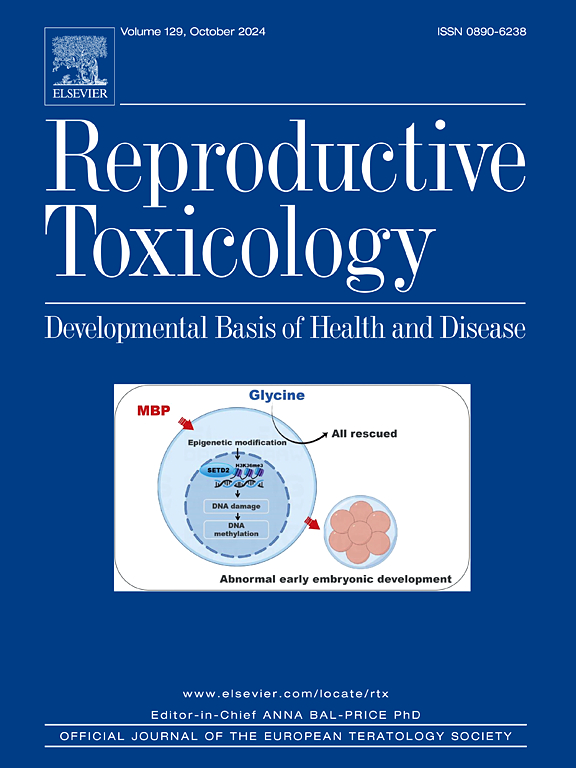Environmental basis for early onset breast cancer
IF 3.3
4区 医学
Q2 REPRODUCTIVE BIOLOGY
引用次数: 0
Abstract
Pregnancy provokes a heightened amino acid requirement, especially in the third trimester. Alterations to late pregnancy amino acid metabolism have been associated with environmental breast carcinogen exposures, including DDT and PFAS. This project examined whether maternal serum amino acids in late pregnancy are associated with subsequent breast cancer risk. Archival third-trimester serum samples from 172 women who were later diagnosed with breast cancer were compared to samples from 351 women without known breast cancer. A prospective metabolome-wide association study (MWAS) for breast cancer cases showed that associated amino acid pathways included lysine, arginine, proline, aspartate, asparagine, alanine, tyrosine, tryptophan, histidine and branched-chain amino acids. Lower mean concentrations of individual amino acids, including histidine, threonine, lysine, and proline, were associated with an increased risk of breast cancer, and network analyses showed that these amino acids were negatively associated with protective breast cancer risk factors. Prospective MWAS for breast cancer cases diagnosed within 15 years of sample collection showed pathway associations for tryptophan, histidine, lysine methionine, and cysteine metabolism. Nutrient stresses caused by low amino acid levels impair immunosurveillance and activate oncogenic mechanisms of cell survival, thereby providing mechanisms by which environmental exposures in late pregnancy can contribute to breast cancer risk.
早期乳腺癌的环境基础。
怀孕会增加对氨基酸的需求,尤其是在妊娠晚期。妊娠后期氨基酸代谢的改变与环境致癌物质暴露有关,包括滴滴涕和PFAS。该项目研究了妊娠后期母体血清氨基酸是否与随后的乳腺癌风险相关。来自172名后来被诊断为乳腺癌的妇女的妊娠晚期血清样本与351名未患乳腺癌的妇女的样本进行了比较。一项针对乳腺癌病例的前瞻性代谢组关联研究(MWAS)显示,相关氨基酸途径包括赖氨酸、精氨酸、脯氨酸、天冬氨酸、天冬氨酸、丙氨酸、酪氨酸、色氨酸、组氨酸和支链氨基酸。个体氨基酸(包括组氨酸、苏氨酸、赖氨酸和脯氨酸)较低的平均浓度与乳腺癌风险增加有关,网络分析表明,这些氨基酸与保护性乳腺癌风险因素呈负相关。样本收集15年内诊断的乳腺癌病例的前瞻性MWAS显示色氨酸、组氨酸、赖氨酸、蛋氨酸和半胱氨酸途径相关。低氨基酸水平引起的营养应激损害免疫监视并激活细胞存活的致癌机制,从而提供了妊娠后期环境暴露可能增加乳腺癌风险的机制。
本文章由计算机程序翻译,如有差异,请以英文原文为准。
求助全文
约1分钟内获得全文
求助全文
来源期刊

Reproductive toxicology
生物-毒理学
CiteScore
6.50
自引率
3.00%
发文量
131
审稿时长
45 days
期刊介绍:
Drawing from a large number of disciplines, Reproductive Toxicology publishes timely, original research on the influence of chemical and physical agents on reproduction. Written by and for obstetricians, pediatricians, embryologists, teratologists, geneticists, toxicologists, andrologists, and others interested in detecting potential reproductive hazards, the journal is a forum for communication among researchers and practitioners. Articles focus on the application of in vitro, animal and clinical research to the practice of clinical medicine.
All aspects of reproduction are within the scope of Reproductive Toxicology, including the formation and maturation of male and female gametes, sexual function, the events surrounding the fusion of gametes and the development of the fertilized ovum, nourishment and transport of the conceptus within the genital tract, implantation, embryogenesis, intrauterine growth, placentation and placental function, parturition, lactation and neonatal survival. Adverse reproductive effects in males will be considered as significant as adverse effects occurring in females. To provide a balanced presentation of approaches, equal emphasis will be given to clinical and animal or in vitro work. Typical end points that will be studied by contributors include infertility, sexual dysfunction, spontaneous abortion, malformations, abnormal histogenesis, stillbirth, intrauterine growth retardation, prematurity, behavioral abnormalities, and perinatal mortality.
 求助内容:
求助内容: 应助结果提醒方式:
应助结果提醒方式:


